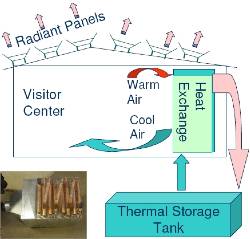The following elaboration of components is compiled from the two pdf
documents prepared by the company.
Night Radiant panels
Shed heat to night sky or day sky when shaded 100 to 400 watts
per sq meter. Chills thermal storage fluid, reaching 10F to 20F
below nighttime ambient.
- Designed to minimize convection and conduction and maximize
radiation heat transfer
- Designed to last over 20 years in outside atmospheric
conditions
- Dissipates between 100-140 watts of heat /square meter panel
- 33 square foot per gallon per night
- 8.8 square foot per liter per night
- Produces 4950 liters per acre per night
Thermal / Wind Shield
Prevents convective warming of panel surface which allows extra
chilling. Creates cold, horizontal stagnant insulating area which
increases efficiency and minimizes thermal gain from surface dew.
- Helps reduce the temperature by 3F
- Should be installed in area where wind speed is greater than 3
MPH. Effective to 8 MPH.
Optional Wind boost
Directs wind away from panels while using wind energy to provide
4 - 7F of additional chilling.
- Increase production by 50% with 7 hours per night of 8 MPH
wind.
- Allow system to be used in warmer and drier climates
Primary Heat Exchanger / Condenser
Transfers cold from the thermal storage fluid to indoor air.
Several different types exist, but the cheapest is basically a set
of 280,000 BTU radiators.
- Chills air during high absolute humidity time of the day
- Provides condensing surface for the water
- Precisely controlled to maximize condensation
- Exit air can be used as conditioned air for cooling
- Effective when thermal storage fluid is at least 2F below
current dew point.
- Note: systems without thermal storage must do condensing
during the night.
Thermal Storage Tank
A tank of fluid which contains the chilled fluid until needed for
cooling purposes. It is normally insulated and buried to retain
cold. Average is 3,000 gallons per 1,000 square foot per day of
storage.
- Optional use for improved performance
- Stores cold at night to use during best humidity conditions
- Sized as 120 to 300 gallons per gallon of condensate per day
- Average system requires 60 to 120 days of production to
replace water invested
- Salt water can be used
- Tank is usually provided locally
- Existing cisterns can be used for thermal storage with
addition of insulation
Micro Controller, Pumps, Valves, Blower, Solar charger, Battery
These components control the circulation of fluid to maximize
chilling to panels and circulation of fluid to heat exchangers to
maintain desired room temperatures.
- Controls thermal conditions for optimal broader range of
operation
- Thermosyphon is used whenever possible to eliminate or reduce
pumping power
- Thermal drop concept is used for air flow to eliminate fan
energy
- Heat pipe can be used to eliminate pump energy
- Optional Geoexchange heat pump can supplement water production
during marginal conditions.
Optional Thermal Chimney
This is a different kind of heat exchanger. It looks like a
chimney and uses diffusion type cold air release at the floor. It
runs completely silent and uses convention to drive air flow,
eliminating the need for most HVAC ducts. It is ideal for retrofit
installs.
Advantages
- Provides ROI over 10 times better than photovoltaic solar
panels at 2007 prices.
- Can delay or remove need for major grid upgrades especially in
areas with peak demand failures.
- Eliminate need for rolling blackouts caused by excess power
demands in the summer. (Air conditioning electricity demand is the
leading cause of summer blackouts.)
- Reduce standby generating requirements by up to 50%.
- Dramatically reduce indirect greenhouse emissions for equipped
buildings.
- Incidental benefits:
- Dramatically reduces roof wear due to solar exposure.
- Dramatically reduces heat gain through roof.
- Dramatically reduces attic temperatures.
Applications
- Off grid guard shacks.
- Locations with expensive power such as Diesel or propane
generators.
- Areas with high peak demand power costs.
- Locations with High human cost if cooling is lost during power
outages such as nursing homes and hospitals.
- Buildings that must stay operational during power outages such
as police and fire stations.
- Businesses in areas where peak demand is causing high risk of
grid failure.
- Areas where large scale grid upgrades are needed to meet
increasing demands.
]
Patents
Portions patent pending.
